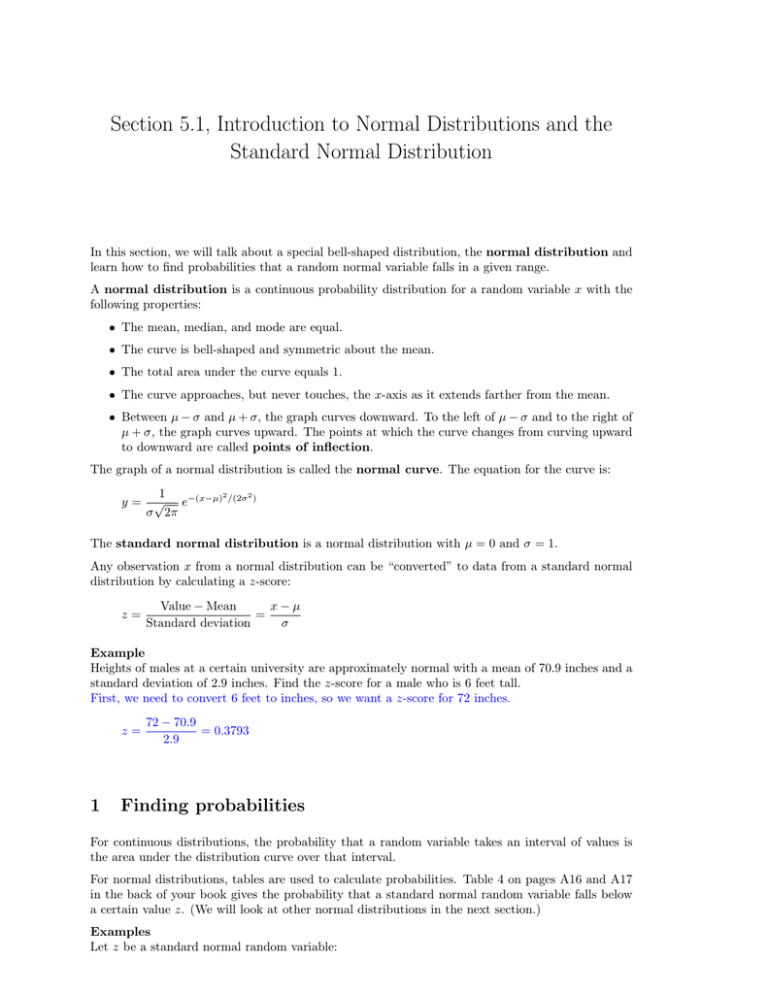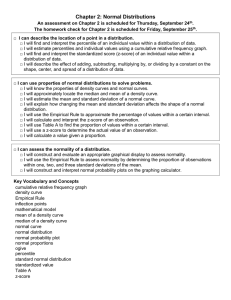Section 5.1, Introduction to Normal Distributions and the Standard Normal Distribution
advertisement

Section 5.1, Introduction to Normal Distributions and the Standard Normal Distribution In this section, we will talk about a special bell-shaped distribution, the normal distribution and learn how to find probabilities that a random normal variable falls in a given range. A normal distribution is a continuous probability distribution for a random variable x with the following properties: • The mean, median, and mode are equal. • The curve is bell-shaped and symmetric about the mean. • The total area under the curve equals 1. • The curve approaches, but never touches, the x-axis as it extends farther from the mean. • Between µ − σ and µ + σ, the graph curves downward. To the left of µ − σ and to the right of µ + σ, the graph curves upward. The points at which the curve changes from curving upward to downward are called points of inflection. The graph of a normal distribution is called the normal curve. The equation for the curve is: y= 2 2 1 √ e−(x−µ) /(2σ ) σ 2π The standard normal distribution is a normal distribution with µ = 0 and σ = 1. Any observation x from a normal distribution can be “converted” to data from a standard normal distribution by calculating a z-score: z= Value − Mean x−µ = Standard deviation σ Example Heights of males at a certain university are approximately normal with a mean of 70.9 inches and a standard deviation of 2.9 inches. Find the z-score for a male who is 6 feet tall. First, we need to convert 6 feet to inches, so we want a z-score for 72 inches. z= 1 72 − 70.9 = 0.3793 2.9 Finding probabilities For continuous distributions, the probability that a random variable takes an interval of values is the area under the distribution curve over that interval. For normal distributions, tables are used to calculate probabilities. Table 4 on pages A16 and A17 in the back of your book gives the probability that a standard normal random variable falls below a certain value z. (We will look at other normal distributions in the next section.) Examples Let z be a standard normal random variable: 1. Find the probability that z falls below 0. By looking up 0 on the table, we see that the probability is 0.5. 2. Find the probability that z falls below 2.74. To find this, we look up 2.74 in the table and see that the probability is 0.9969. 3. Find the probability that z falls below -0.93. To find this, we look up -0.93 in the table and see that the probability is 0.1762. 4. Find the probability that z is at least 0.62. Looking up 0.62 in the table gives us that the probability that z is less than 0.62 is 0.7324, but these are complementary events, so the probability that we want is 1 − 0.7324 = 0.2676. (Note the value in the table for −0.62 is also 0.2676. This happens due to symmetry.) 5. Find P (z ≥ −2.6). Note that P (z ≥ −2.6) = 1 − P (z < −2.6) = 1 − 0.0047 = 0.9953. 6. Find P (−0.24 ≤ z ≤ 0.43). From the table, we know that P (z ≤ 0.43) = 0.6664 and P (z ≤ −0.24) = 0.4052, so the area in between the two values is 0.6664 − 0.4052 = 0.2612. 7. Find P (z = 1). We can think of the above probability as P (1 ≤ z ≤ 1), then use the reasoning from the last part to get that P (z = 1) = 0. We can also get this answer with the “area under the curve” definition for probability, which leads us to a rectangle of width zero, which has area zero. 8. Find P (z ≤ −4). This number isn’t on the table, but by following the patterns, we see that P (z ≤ −4) ≈ 0. 9. Find x such that P (z ≤ x) = 0.9222. Now, we want to find a probability on the table, and use that to get the value for x. Finding 0.9222, we see that it corresponds to a z-value of 1.42, so x = 1.42. 10. Find the first quartile for a standard normal distribution. Here, we want x such that P (z ≤ x) = 0.25. The closest probability to 0.25 on the table is 0.2514, corresponding to x = −0.67, so Q1 ≈ −0.67.







